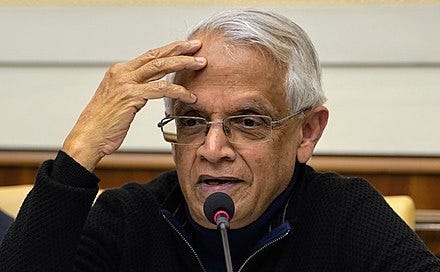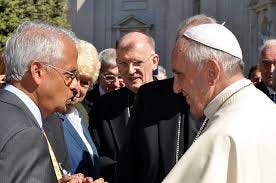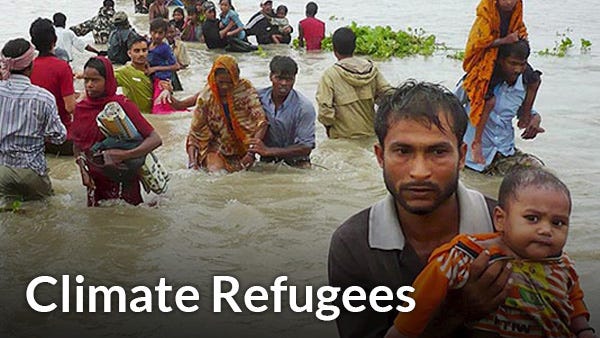HOW CLOSE TO CLIMATE CATASTROPHE ARE WE?
A Short, Sobering Talk with a Scientist Who Saw It All Coming
This first episode of HOT GLOBE™ arrives between Halloween and COP27, the world's climate gathering in Sharm el Sheikh, Egypt--a doubly spooky time for the planet. I talked with Veerabhadran Ramanathan from his house near the Scripps Institution of Oceanography where he is the Edward A. Frieman Endowed Presidential Chair in Climate Sustainability (Emeritus), and Distinguished Professor (Emeritus) of Atmospheric and Climate Sciences
Veerabhadran “Ram” Ramanathan
"Ram," as everybody calls him, discovered the greenhouse effect of CFC's, when this was considered almost heresy, and proved that methane and other gases contributed almost as much to the heating of the planet as CO2 emissions.
When the now 78-year-old scientist came to America in 1970, his very American goal was simply to drive an Impala Chevrolet. But he had a strong talent for engineering. His first job in India was working on refrigerators. This proved prophetic when he became a young atmospheric chemist in America. He understood refrigerants. He understood how gases worked. Later he discovered how pollutants created "brown clouds" over South Asia so large that they influenced monsoons and rice yields. But he stayed focused on his science.
Then in 2007 a student from Africa came up to him after a lecture, “’Professor Ramanathan, you made us cry with your story, but you didn’t tell us what you’re doing about it.’ I couldn’t tell her anything I was doing about it. I didn’t answer. She dumbfounded me.” In response, he invented a new type of low-tech cooking stove that could be used by millions without gas or electricity to cut the smoke from cooking fires like the ones that had made his own grandmother cough. He decided that scientists did not do enough to communicate the dire threat of what he saw coming. He took the warning not just to the media and the US Congress, but to religious leaders. His discussion with Pope Francis--which famously took place in an open parking lot at the Vatican--resulted in the “Climate Encyclical,” a call to action for the planet’s 1.4 billion Catholics.
Ram Ramanathan with Pope Francis in 2015
Steve: How close to a climate catastrophe are we, Ram, and why don't enough people see what scientists see?
RAM: Very few of the general public realize that we are this far along in climate change and related weather extremes triggered by climate change. My view is that we as scientists have not reached out enough to the public at large. Very few read our reports and scientific articles and perhaps even articles written in media like the New York Times.
Very few know or comprehend how close to a disaster we are. For example, a third of Pakistan was underwater this summer.
“When we reach 1.5C, which in my estimate will happen in eight years (give or take a few years,) about three billion people, who are the poorest among us, will be facing a cliff, and they could fall off that cliff any time extreme weather like floods or heat waves comes into their neighborhood like what happened in Pakistan this year.”
The US, Europe, and the wealthy in India and China, might be able to struggle along to 2 or 2 ½ degrees. It may not be climate change that would directly upset the livelihoods of wealthy nations as well as wealthy people in not so rich nations.
“It could be social systems and governance breaking down first, not the natural systems.”
Many of us, even in the US, might not survive a calamity of natural systems, but the super wealthy, say the Elon Musks of the world, can.
Coming back to the poorest three billions, who had very little to do with the emissions of heat trapping pollutants but are suffering the most from weather/climate extremes, the sheer desperation they face through loss of loved ones, homes and livelihoods in rural areas could drive them to mass migration and all the calamities it causes across international borders. As former California Governor Jerry Brown emailed me, it could lead to a new form of climate terrorism among the poorest three billion targeting the wealthy--one form of the breakdown of social systems resulting from climate change.
It's one thing to talk about taking a few hundred thousand climate refugees into California, but with an increase of 2 degrees, there could be hundreds of millions of climate refugees around the world.
STEVE: Eight years is a very short time, indeed. Are there any error bars around that?
RAM: When I talk to the general public, I talk about a range. If there were to be a major volcano, the climate cooling by sulfate particle clouds could delay it by four years; or a five years to a decade long la nina [a cooling of the water in the equatorial Pacific] that would delay it. I am saying the uncertainty is 3-5 years, so 2027-2035. Look, the IPCC committee of the UN claimed until last year, that the 1.5C warming will not happen until mid 2040s. Perhaps due to our paper or likely others they have now revised their estimates, and concluded that the planet will cross the 1.5C threshold by early 2030s.
Weather extremes have surprised us in so many ways. Bizarre ways. If the reckoning is coming early, like 1.5C by 2030, it is, in an insidious way, good for the planet and its people.
“The impacts of 1.5C will be so large, that people, including climate skeptics, will wake up and demand actions from their governments, very similar to the climate actions related youth movement.”
If, on the other hand, the 1.5C warming doesn’t happen until the 2040s, then 500 billion more tons of CO2 would have been added to the atmosphere by 2050. The sooner someone puts a gun to our heads the better for preventing a climate catastrophe.
“Look, there is an opportunity to change.”
We have started to address methane and other non-CO2 heat trapping pollutants like HFCs, tropospheric Ozone and black carbon soot. These pollutants, also called Short-Lived Climate Pollutants, are contributing about 45% of the current global warming.
It would give us some years if we can drastically cut the emissions of these non-CO2 heat trapping pollutants. California, under Gov. Jerry Brown, is one of the first states that already passed a bill to reduce these short-lived climate pollutants. We know how to reduce these pollutants and doing so will save millions of lives worldwide from air pollution related deaths.
STEVE: You've taken individual approaches in your personal life, and you see the big picture, obviously. Is there a contradiction between the approach of, say, Peter Kalmus and his excellent book, Be the Change, and climate scientist Michael Mann, who essentially says we must halt the fossil fuel industry, period?
RAM: Scientifically, I admit, it’s sort of too late for individual actions to bend the warming curve noticeably. But individual actions help communicate the crisis.
I see three worlds living side by side in the planet. The top one billion people (13% of the total population,) the middle four billion (47%,) and the rest is the poorest three billion (40%.) The wealthy one billion are responsible for at least 50% of the pollution and have the capacity to finance the emission reductions. The rest of the population do not have the capacity and if the government does nothing to bend the warming curve, they will suffer and many will succumb to extreme weather.
This year alone we’ve had month long heat waves, in India non-stop, China, Europe. The floods.
STEVE: Is geo-engineering a solution?
RAM: Fighting climate change is a race against time. We may be forced to take desperate steps. If social systems break down, every person, every nation will want to do it, but if that allows you to keep putting more and more CO2 in the atmosphere, generations to be born will have to bear the consequences, both intended and unintended ones. When do you stop dumping these harmful pollutants in the air? The atmosphere, as of today, already has a blanket of one trillion tons of CO2, that were dumped over the last 150 years.
If we can show we can do geo-engineering, then the fossil fuel companies will likely keep digging up more fossil fuels from below. Currently, we put 40 billion tons of CO2 a year but that could go to 125 billion tons per year after 2050 if we meet the energy needs of a growing, wealthier population worldwide, with just fossil fuels.
“The issue I have with geo-engineering is that it cools the climate by reflecting more sunlight back to space and reducing sunlight reaching the sea surface; cutting sunlight reaching sea surface will dry out parts of the tropics.”
The rainforests get their moisture from evaporation of water vapor from the sea surface. There are unintended consequences from cutting sunlight to the surface of the ocean. As for taking CO2 out of the air, we have no scalable technologies to rake out several billion tons of CO2 out of the air.
STEVE: What would you like to come out of COP27 next week?
RAM: Good question. First thing, some way to compensate for all those who are suffering, particularly those living in developing nations; the poor, who have relatively little to do with the pollution but are suffering. Of course, the poor in nations like the USA also need public support to build climate resilience. There are lawsuits but, in my opinion, lawsuits won’t solve the issue. We need to set up funds to compensate for loss and damage.
Second, we need enforceable drastic actions to cut emissions of CO2 and other heat trapping pollutants and bend the warming curve. I would like to see binding commitments by nations to reduce CO2 and other pollutants. We cannot give up on mitigation.
Third, I would like to see firm commitment with funds to restore natural systems, including biodiversity, that are being destroyed by weather/climate extremes like droughts and fires. Just to take the California example, we had 33 million acres of forest in California decades ago and 12-14 million have either burned or exposed to massive fires since the 1980s. When are we going to take action? We need to build climate Resilience for People and for Nature.
STEVE: Binding is the tricky part, isn't it?
RAM: Binding is the tricky part. You asked me to dream, Steve!









